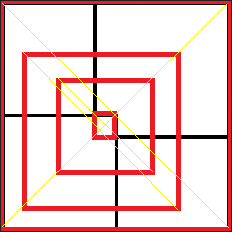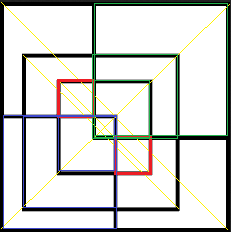119
points
Questions
22
Answers
13
-
There are 12 squares in the picture.
The trick to find it would be drawing diagonals. We know that the sides of a square are parallel and thus, the diagonals should be parallel as well. Let us begin with the outer most rectangle. See the picture. The yellow lines are diagonals drawn for reference.

You can make out four squares in the image.

Now see the next image. You can make out a total of 8 squares – 3 blue, 3 green and 2 red. There are 4 other rectangles in the figure but they can’t be square as their diagonal is not parallel with the yellow lines we drew for reference.
Thus, total squares = 4 + 8 = 12.
- 8660 views
- 2 answers
- 2 votes
-
He will burn one of the rope at both the ends and the second rope at one end. After half an hour, the first one burns completely and at this point of time, he will burn the other end of the second rope so now it will take 15 mins more to completely burn. so total time is 30+15 i.e. 45mins.
- 6086 views
- 1 answers
- 0 votes
-
You want to place the first coin.
There are two key insights in this question that must be reached, otherwise the solution does not hold. Here’s the first: you must place the first coin in the middle of the table.
First imagine a round table so small that only one coin can fit on it. In this case, the person who goes first will win. Now imagine the table grows so that it is large enough to fit more than one coin on it. Given that the table is round and the first coin has been placed in the middle, another ring of coins can be placed around the original coin. This ring of coins will contain 6 coins (try for yourself with some coins or poker chips, it can also be proven with some geometry but let’s not go there!). Because there is an odd number of coins on the table, the player who goes first wins again.
But what if the second player does not place their coins neatly beside each other on the table? Here is the second insight: wherever the second player places his coin, the first player places his next coin opposite it, on the other side of the centre coin. Because the table and the distribution of the coins in symmetrical, wherever the second player places his coin, there will always be a space opposite for the first player to place another coin. The first player’s coins are dark blue.
Now imagine that the table is bigger still, and it can hold another round of coins. This second round of coins will contain 12 coins. Again, the first person to place a coin wins. No matter how large the table becomes, the additional rings of coins will always have an even number and symmetrical properties. The first player always puts his coins opposite the second player’s coins. There will always be an odd number of coins on the table at the end so the person who goes first will always put the last coin on the table. The second player will always lose.
- 9715 views
- 1 answers
- 0 votes
-
The short short version is that this is an artifact of the idea of casting out nines: the sum of a number’s digits gives the same remainder on division by 9 that the original number does. For instance, 431=9×47+8, and 4+3+1=8. Since X and Y have the same digits, they have the same digit-sum, so they have the same remainder on dividing by 9. But this means that their difference D is a multiple of 9; and that means that D’s digit-sum is a multiple of 9 (since it must give the same remainder on dividing by 9 that D does). When a non-zero digit is hidden, it’ll reduce the digit-sum of D by that much, so all you have to compute is the digit from 1—9 (and note that there will always be a unique digit – this is why the ‘nonzero’ restriction is there, because otherwise there’d be no way to tell a zero from a nine) to add to the digit-sum of D to bring it up to a multiple of 9.
- 5662 views
- 2 answers
- 1 votes
-
Boris puts the ring in a box and locks it with one of his padlocks, and sends the box to Natasha. Natasha attaches one of her padlocks (so now the box is locked with two locks) and sends the box back to Boris. Boris removes his padlock and sends the box back to Natasha. Natasha removes her padlock, opens the box, and removes the ring.
Attack
Of course the corrupt postman will withhold the box Boris sent, add one of his (the postman’s) own padlocks, send it back to Boris, who will unlock his padlock so that the postman can open the box with his key.
- 6222 views
- 1 answers
- 0 votes
-
The Bear will be of White Colour.
As S=UT+1/2AT^2 …
Using this formuls , we get the value of a that is found to be greater than 9.8…that happens only on poles so that bear will be polar bear…and polar bears are white in colour.
- 10826 views
- 1 answers
- 0 votes
-
yes it is possible….
position of the light bulb which is in on state is not given so assume that they are adjacent as…b1(on) b2(on) b3(off) b4(off) b5(off)……………………………. b2014(off) (assume it is in circular path)
now as two bulb is in on state and remaining 2012 bulbs are in off state
clearly all 2012 bulbs which is in off state are adjacent ,now we will operate on these 2012 bulbs as….we can choose any bulb and able to make two bulb adjacent to it in on state.now choose anyone of two bulb to which we just turn in on state and made two more bulb in on state.
so clearly we can make four adjacent bulbs in on state.(ex- at starting all four bulbs are in off state as
1(0ff) 2(0ff) 3(0ff) 4(0ff)
choose 2nd bulb and turn 1 and 3 in on state…as
1(0n) 2(0ff) 3(0n) 4(0ff)
now choose 3rd bulb and turn 2 and 4 in on state…as
1(0n) 2(0n) 3(0n) 4(0n)
)by repeating these steps we can turn all 2012 bulbs in on state (4*53=2012)
so now all 2014 bulbs are in on state…………………….- 9426 views
- 1 answers
- 0 votes
-
contsainer should be of volume 1,3,9 & 27
- 7382 views
- 1 answers
- 0 votes
-
min 2 and max is 12
lets suppose he decided to wear white (or black) socks and he start picking socks and he gets first two socks white (or black ).so total is 2.again he decided to wear white (or black) socks and he start picking socks and he gets first 10 socks black (or white) and after that he will definitely get 2 white socks (or black) socks ,so total is 12.
- 18856 views
- 2 answers
- 0 votes
-
Capacity —10 10 5 4
Intially — 10 10 0 0
10 6 0 4
10 6 4 0
10 2 4 4
10 2 5 3
10 7 0 3
10 7 3 0
6 7 3 4
6 7 5 2
6 10 2 2- 7915 views
- 1 answers
- 0 votes

